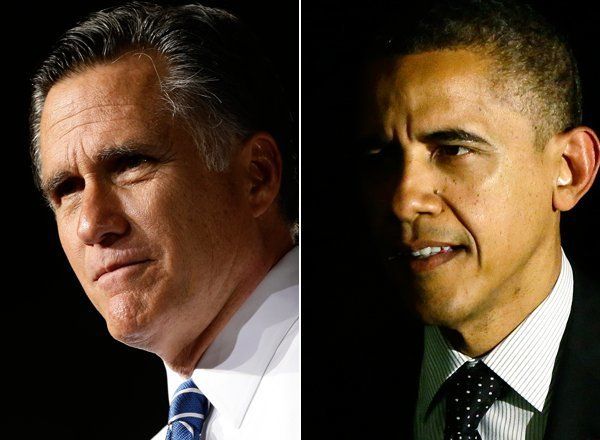
Watching the first presidential debate last week, Americans may be forgiven for losing sight of the differences between the candidates in the details. Republican candidate Mitt Romney and President Barack Obama managed to agree both on broad themes and policy specifics. When asked about their understanding of the role of government, both heralded foremost our military and our education system. The military is usually the darling of the Republicans, education the sweetheart of the Democrats. But here they were, Romney declaring "I love great schools!" (see this graphic for all of Romney's loves), Obama touting his role as Commander-in-Chief, and both nodding in approval of the other across the split screen. Moreover, thanks to some significant backtracking on Romney's part, they were also in agreement not just about funding for schools, but also about taxing the rich, the importance of regulations, and even healthcare mandates.
At the same time, however, Americans are told that the candidates are offering us different visions for the future of our country, indeed two distinct understandings of our country's very nature. From the left we hear of government that works to improve the condition of all Americans, while the right disparages government and instead empowers individual Americans to improve their own lot. Joe Biden claims he does not recognize the country the Republican Party invokes, while Paul Ryan declares that Barack Obama's idea of governance is "entirely foreign to anything this nation has ever known."
There is a paradox at play here. Americans are more politically divided than they have been in a very long time. At the same time, our parties are closer together and more ideologically coherent than in most other democracies. Our partisanship is dramatic, but hardly revolutionary.
There are technical and theoretical reasons for our political coherence. Technically, it is a product of our electoral system. With a first-past-the-post ("winner-takes-all") voting system, our electoral contests are won with a simple majority. In other words, if a district gives a candidate 60 percent of their votes, that candidate wins full representation; the loser does not get to represent 40 percent of constituents nor even 1 percent. That's also why all of Ohio's Electoral College votes will go to one candidate on election night, regardless of how closely split the electorate may be (Maine and Nebraska are the only exceptions to this in the U.S.). The most significant effect of this system is what political scientists call Duverger's Law: it favors a two-party system. Weak parties will either fuse together to compete, or they will lose support because they have no chance of winning.
This differs from proportional representation, the system utilized by most parliamentary democracies, in which parties are represented in proportion to the votes they have won (usually beyond a minimum threshold). Duverger also posited that proportional representation favors multi-partism. In the United Kingdom's last general election of 2010, the Conservative party won the largest percentage of the vote (at only 36 percent that would be considered a great loss in the U.S.) and took the greatest number of seats in parliament; the Liberal Democrats came in third with 23 percent of the vote, and claimed seats as well. As a result of the proportional representation system, other democracies have much more variegated and diverse party politics that even verge on the anti-systemic (i.e. revolutionary). In most European countries it is common to have communist parties on the ballot with extreme right-wing nationalists, and everything in between.
For us in the U.S., that means it is in the interest of the two parties to function relatively close together. The reasoning is not much different from the logic behind two gas stations on one intersection -- they will attract everyone from their side of the neighborhood, plus some in the middle. But how did American politics end up at this particular intersection? Why is the American center located where it is, relatively rightward of other centers in similar countries (consider that even conservatives in Britain do not question universal health care).
One convincing theory is based upon path dependence, telling us that our past is highly determinant of our present. Declaring America "unusual," John Kingdon argues that because of the migration (opportunity to make money) and localism (independence from religious and political authority) at our origins, distinctive early American ideas were framed by individualism and suspicions of authority. These ideas naturally embraced liberalism and republicanism, and evolved into institutions of limited government, bicameralism, separation of powers, and federalism.
Of course we have evolved from those early years. Our needs have increased (including need of protection from exploitation and discrimination) and we have called on our government to provide for them. But because our early ideas were embodied in principles and solidified in institutions, we are for a long time bound to them. That is why Barack Obama could never be a radical socialist -- he did protect Wall Street and he always will protect America's corporate and financial interests and the idea of free market capitalism. That is also why Mitt Romney will never really neglect the center; he will not eliminate social protections entirely, despite his apparently deeply inimical sentiments on the matter. Even if the conservative base in America has become quite anti-systemic, American political parties continue to function within a relatively coherent system of values and practices. For now, at least.
A version of this essay first appeared on Aslan Media.